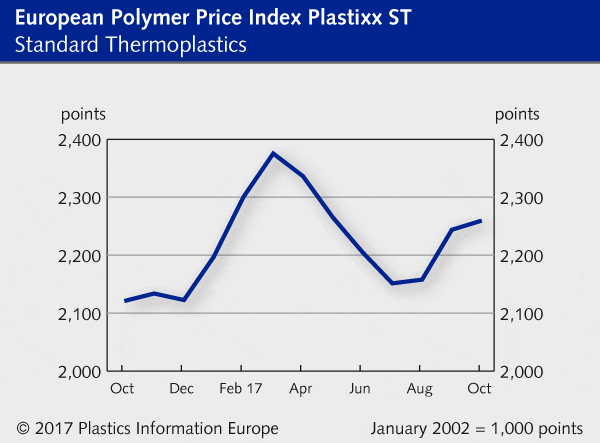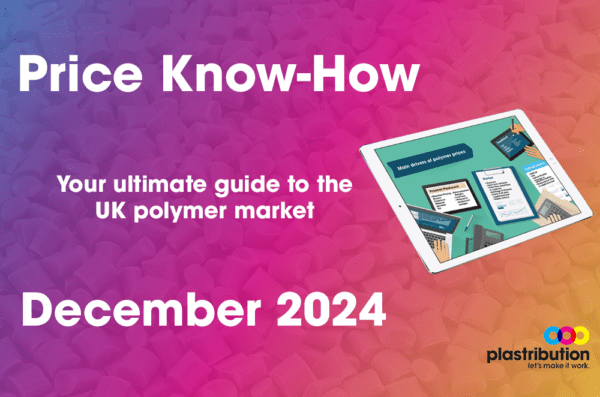
Polymer Price Reports Released for October 2017
The latest polymer price reports and charts have been released by Plastics Information Europe (PIE).
Standard Thermoplastics October 2017: Overall marginal increases / Cost transfer prevails with few exceptions / Discounts on styrenics and PET in sight for November / Demand falls
PE: Improved availability of some PE materials undermined producers’ intentions to push through increases. By the end of the month, there were only price hikes in cases where notations were particularly low in the first place. Most buyers had to fork out no more than the EUR 30/t rise in the cost of C2. Only with LLDPE (C4) film grades were producers also able to push through margin increases due to the limited supply. Fewer imports and the outage of Versalis’s facility in Dunkirk / France had a big impact. In November, development will depend on how severe the influence of the force majeure at Borealis will be. This is not clear because no details have been given on which types are affected. There could be restrictions only for certain products. In the low-pressure segment, there could be a delay with the C4 film grades. A lot depends on when imports start arriving again from the US. Converters are expected to hold back on purchasing activity in November. Many companies have fairly full order books, but also adequate stocks. The season is also coming to an end for building materials like pipes. Above-average ordering activity is not likely.
PP: In October, PP producers in western Europe for the most part were unable to make the hoped-for margin gains as cheaper polymer from central European production entered the market to bridge the tightness gap. While suppliers of homopolymer were largely able to pass on their higher costs, copolymer producers were not always able to, and here the rate of price increase was lower. The already high prices and somewhat firmer margins kept many buyers away. Compounds followed the trend of the entire propylene chain. In major part, compounders were able to pass on their own higher cost. For November, both cost development and the market situation point to a sideways trend.
PVC: In the course of October, Europe’s PVC producers were forced to acknowledge that the original price rises they had intended to push through were too ambitious. The fall in demand, especially in the underground engineering sector, left no scope for hikes in the first month of the fourth quarter. Hence, the producers ultimately passed on the pro-rata price rise for ethylene. This similarly applied to paste grades and flexible compounds too, where prices only reflected the increase in the matrix material. For rigid PVC compounds, by contrast, the renewed cost rises for titanium dioxide and stabilisers had a disproportionate impact, in the same way as in the past few months. The signs for November are pointing primarily to stagnating notations. One exception will be non-plasticised compounds, where additives are still exerting upward pressure.
Styrenics: The downward correction of SM by EUR 110/t also provoked sinking styrenics prices. PS fell the most, as the entire cost reduction was usually passed on to processors. For EPS, several suppliers kept part of the reduction by leveraging with the tight supply. Discounted amounts varied between producers. The price development for ABS was also modest, since increased butadiene and ACN costs dampened the decline in composite costs. The supply situation for EPS, especially insulation materials, remained difficult. By contrast, desired volumes of PS and ABS were largely available, as many processors put their bets on further discounts in November and postponed their orders where possible. Indeed, the SM reference contract fell by EUR 90/t. Styrenics producers will try to withhold parts of the cost reduction again. However, this will be more difficult for them than in previous months, especially for PS and ABS.
PET: Even the most delightful party comes to an end sometime. Over the past few months, Europe’s PET producers have had much more fun than they have had for a long time, since they succeeded in increasing their margins. This good mood rapidly deteriorated again in October 2017, however. On the one hand, notations in Asia fell, prompting the arrival of a third more imports, with aggressive price labels. On the other hand, the summer beverage season, and hence bottle season, quietly came to an end, prompting a slump in demand. Against this background, PET prices logically moved downwards, even if the decline has not yet assumed dramatic proportions. This would seem to clearly indicate a turning point in the downward trend that has been prevailing on the world’s oversupplied polyester markets for many years. For November, at least, further price reductions are to be expected, even if upward tendencies are evident in the Americas due to discontinued production at M&G.
Engineering Thermoplastics October 2017: Market tends firm / Minor falls with PC and PA 6 / Prices otherwise stable and trending upwards / November expected to continue firmer
In October, PC and PA prices on the European market fell slightly. The supply situation was so good that producers had little option but to pass on at least part of the cost reductions from the previous weeks. The picture with PA 6.6 was a little different and prices were only kept stable through competitive overlap with PA 6. PBT went up yet again, while PMMA took a short breather. POM remained stable, but there have been one or two signs of movement lately. With PP compounds, the higher costs were factored in. Conversely, ABS notations fell due to the decline in the SM reference price.
In November, the market could consolidate on a broad basis. Materials that have recently been tending weaker should stabilise and the upward trend with the others will become stronger. This means at least moderate increases must be expected with many grades of PA 6.6, PBT, POM and PMMA.
For more than 34 years, PIE has been an invaluable source of information for European plastics industry decision makers – a quick, yet in-depth look at the development of plastics markets and polymer prices. Available online 24/7 and as a printed newsletter twice a month. To read the entire report, go to www.pieweb.com and sign up for a 48-hour free trial!







